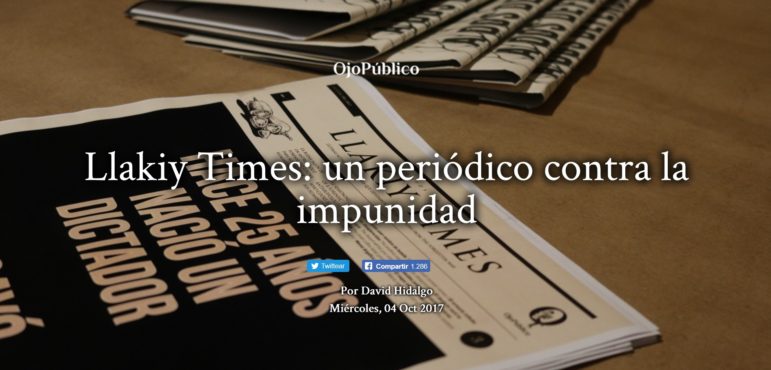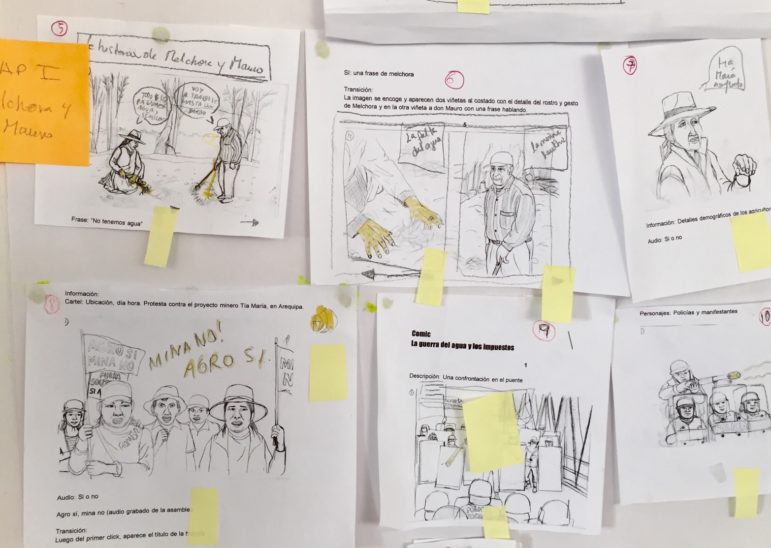

Online to Print: Ojo Público Experiments to Raise Human Rights Awareness
Read this article in
“Twenty-five years ago a dictator was born and a mass killer fell,” reads the cover of the Llakiy Times in bold white letters against a black background. Llakiy means sorrow in Quechua, one of Peru’s official indigenous languages, and the recent headline refers to two major events that happened in Peru in 1992. First was the shutting down of the Parliament and the suspension of the Constitution as well as the judiciary by then-President Alberto Fujimori, which came to be known as a self-coup; and second, the capture of Abimael Guzmán, leader of the terrorist group Sendero Luminoso (Shining Path).
 While these events aren’t exactly news today, they remain major events in the history of Perú and its 20-year conflict between terrorists and security forces. It’s these human rights violations and the wounds they left that investigative news outlet Ojo Público seeks to raise awareness about through their new project.
While these events aren’t exactly news today, they remain major events in the history of Perú and its 20-year conflict between terrorists and security forces. It’s these human rights violations and the wounds they left that investigative news outlet Ojo Público seeks to raise awareness about through their new project.
While traditional news outlets are migrating to digital platforms, this digital outlet is taking the opposite path to reach its goal: Utilizing print to reach a wider audience.
“The Llakiy Times is an editorial and journalistic experiment that aims to turn the investigations we publish digitally into permanent documents and give them a format that any person can see, anywhere. That, in a way, provokes readers’ curiosity about what we are doing,” explained David Hidalgo, Ojo Público’s director. The publication “translates into a more familiar and essential language some very hard topics that are part of our investigative line,” he added. Seeking to tap into an international audience, the publication is also bilingual, with each story featured both in English and Spanish.
Llakiy Times comes out in a sensitive year in terms of security and human rights in Peru, according to Hidalgo, with the possibility of Fujimori receiving a pardon. The edition recaps some of the human rights violations and killings committed during the conflict, reminding readers of some of the issues still pending in the country while still approaching history with a new lens.
To try to attract new readers who might not be as interested in learning about human rights abuses committed in the Andean country, the 12-page publication, which can also be downloaded as a PDF, presents a series of micro-stories that refer to the publication’s larger pieces and investigations. The pieces boast attractive designs and appealing pictures taken by some of the best-known photographers in Peru.
The articles range from the story of a forensic anthropologist who turns to cooking to cope with the stress of investigating mass killings to the reproduction of a map drawn by a witness that helped find the bodies of 10 people executed by the anti-communist death squad Grupo Colina 25 years ago. The pieces are moving and invite the reader to find out more.
This is not the first time Ojo Público has taken on Peru’s human rights violations, nor the first time it’s used innovation to present information in a more visually appealing and engaging way. Earlier this year, it launched Proyecto Memoria, a platform with investigations and stories on the conflict and its victims that uses illustrations and data visualizations to convey compelling information.
Times Series
Llakiy Times is the first in a series of six print publications that Ojo Público will publish on different topics. The next edition will be on the pharmaceutical industry, based on an investigation published earlier this year on the cost of medicine in Latin America.
“With these short stories that always have a curious or surprising angle, we look to engage the reader and invite him or her to reflect on some of the topics we cover,” Hidalgo said. The design and visual content seek “to create an object that is so shocking that people read it and keep it.”
Ojo Público is trying to grow beyond its digital audience and appeal to people who read physical newspapers, as well as those who like special editions, providing a complementary product to their online publication.
The ultimate goal?
“To make the reader think about something transcendental,” Hidalgo said. “To surprise them so that they discover, so that they understand.”
 This post first appeared on the IJNet website and is cross-posted with permission.
This post first appeared on the IJNet website and is cross-posted with permission.
Belén Arce Terceros is a journalist specializing in international and humanitarian affairs.










